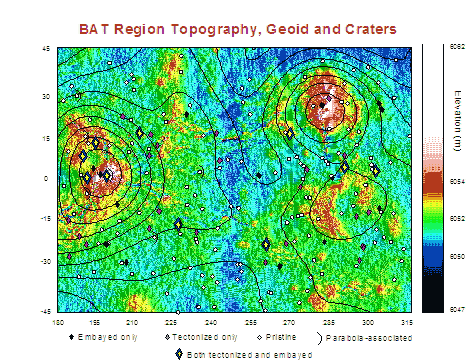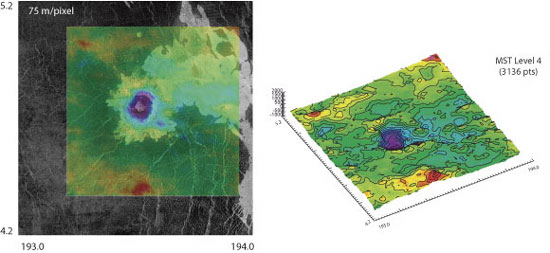 |
 |
Modification
of Impact Craters in the Beta-Atla-Themis Region,
Venus |
 |
|
|
Introduction
Structures at three different scales
have been attributed to plumes on Venus: large topographic
rises, or regiones, extending 1000's of km (Solomon
et al., 1991; Smrekar et al., 1997), fissure or dike
systems radiating 100's of km (Grosfils & Head,
1994; Ernst et al., 2003), and the 300-500 circular
constructs termed “coronae” with diameters
generally 100-300 km (Stofan et al., 1992; DeLaughter
& Jurdy, 1999). Approximately 1000 impact craters
are located on Venus' surface, nearly randomly distributed.
The modification of a crater or its ejecta by disruption
or embayment by lava from outside documents local tectonic
and/or volcanic activity (Phillips et al., 1991; Herrick
et al., 1997). Parabolic deposits associated with some
craters give their approximate age (Campbell et al.,
1992; Basilevsky, 1993; Basilevsky & Head, 1998;
2002; Basilevsky et al., 2003), thus dating activity.
Also, dip of the crater floor, which forms initially
flat, indicates later reorientation (Connors, 1992).
Thus, analysis of impact craters can provide clues about
the timing, extent and nature of tectonic and volcanic
processes to give further insights on the existence
of diapirs or plumes on Venus.
The BAT Region
We focus on the Beta-Atla-Themis (BAT)
region (± 30º N, 180º-300º E), the intersection
of three rift zones defined in the global map of Venus
(Price & Suppe, 1995) (Figure 1). BAT most probably
has been active recently and may still be active currently,
with planetary geoid highs, profuse volcanism, and numerous
coronae. Because of the high level of volcanic and tectonic
activity here, this is the most likely location on Venus
for plume activity. Rifts and large volcanic edifices
dominate both the Beta and Atla Regiones, with Atla
containing some of the largest volcanoes in the planet
(Crumpler et al., 1997). Themis Regio is dominated by
coronae ranging in size from 200 to 500 km diameter
(Stofan et al., 1992; Smrekar et al., 1997). Coronae
have been defined as circular to irregular volcano-tectonic
features (Price & Suppe, 1995) interpreted to result
from rising diapirs (Stofan et al., 1992). These three
regiones are part of the 9 broad topographic rises interpreted
as surface manifestations of mantle upwelling (Smrekar
et al., 1997). The BAT region as defined contains 153
impact craters: 102 pristine, 30 tectonized-only, 10
embayed-only, and 11 both tectonized and embayed. Although
the BAT region covers just 1/6th of the planetary surface,
fully 23% of Venus’ modified craters and most
of Venus’ craters that have been both tectonized
and embayed (61%) occur in this region (Matias &
Jurdy, 2002). |

Figure 1: The BAT region with geoid and craters.
Location of pristine (open circles) and modified craters
(open diamond - tectonized; solid diamond - embayed;
double diamond - both tectonized and embayed). Parabola-associated
craters are indicated with a dark parabolic symbol.
Magellan altimetry data is shown in the background.
|
We studied a total of 33 out of ~150
impact structures located within the BAT region. Impact
craters smaller than ~15 km in diameter cannot be resolved
from Magellan altimetry, but very few of these exist
due to Venus’ thick atmosphere. Location limits
the identification of craters in the altimetry data,
with those craters in the rift zones generally indistinguishable
from the surroundings. Figure 2 shows crater Melba,
this crater on Atla has been classified as embayed.
Lavas from the northeast flow over part of the ejecta
blanket but not into the crater interior. This region
currently dips moderately to the NE. It is possible
that the radar-bright flows changed direction as the
regional dips changed.
Some patterns emerge from the analysis
of these craters in the BAT region. For instance, among
the nine craters both tectonized and embayed, those
located on Atla and Themis Regiones suffer predominantly
tectonic alteration. However, craters Richards and Bashkirtseff
on Atla do show evidence of multiple episodes of embayment.
In contrast, on Beta the corresponding group of craters
has experienced more embayment than tectonic disruption.
Craters on Atla document its activity as recent and
possibly even current. In general, Atla’s craters
dip away from the rift, but Beta’s craters do
not show the same dip pattern. Thus, it appears that
Atla is more active than Beta, and possibly even currently
active. |

Figure 2: Melba (4.7 N, 193.4 E,
22.2 km). Stereo imaging topography (color) nicely overlays
the F-MIDR radar image for Melba. |
Impact Craters and
the Giant Radiating Dike Swarms
We consider craters to further differentiate
between models for radiating graben-fissure structures.
Individual craters can provide a snapshot of the nature
and degree of tectonic and volcanic activity as well
as their timing at a specific location. The southern
region of the Ernst et al. (2003) study area (24º-45º
N) contains five of the impact craters in our data set.
This area contains six of the giant radiating systems
of which five were determined by Ernst et al. (2003)
to be underlain by dike swarms based on extension beyond
the uplift [Editor's comment: see also Giant
Dikes and Giant
Radiating Dyke Swarms pages].
A total of 23 craters are located between
24° and 45° N, with very few showing tectonic
or volcanic modification. Based on the classification
by Herrick et al. (1997), this region contains two tectonized-only
craters and a single crater that has been both tectonized
and embayed. Our approach differs from that of Grosfils
& Head (1996) who only consider craters directly
associated with lineaments and/or flows. We found little
evidence of crater modification by embayment. The single
crater showing encroachment by lava, Raisa (27.5º N,
280.3º E, 13 km) has been heavily embayed and also shows
some tectonic disruption of its rim and ejecta. It lies
~400 km from the center of the R8 radiating system near
a lineament. This system is considered the youngest
of the radiating-graben systems in Beta Regio (Ernst
et al., 2003).
Venus' radiating fissure swarms have
caused surprisingly little modification of impact craters.
Almost all craters near the extensional lineaments remain
pristine. If shallow and recent magma sources had generated
the radiating systems, then we would expect to find
many more craters embayed by lava. The other scenario
for the formation of radiating swarms requires an uplift
caused by an ascending diapir. However, the craters
within radiating systems do not dip away from the center.
Instead, they dip more randomly, often toward the center
of the radiating system, suggesting it has collapsed
since the time of impact. Thus, the radiating systems
may have formed before the impacts, as was concluded
by Grosfils & Head (1996).
Impact Craters and
Coronae
Coronae near Atla and Beta Regiones
have very few impact craters adjacent to or inside their
rims. Only four coronae contain craters: one tectonized
and embayed, two tectonized-only, and one pristine.
The single pristine crater (Aethelflaed) has recorded
different regional dips that may document the evolution
of a currently old-stage corona. The crater deficit
within coronae and the adjacent region, along with the
strong evidence for tectonic modification of associated
craters argues for a tectonic rather than an impact
origin for coronae. A diapir model for coronae could
account for their topographic evolution as well as crater
modification, orientation, and ultimate removal. |
Conclusions
-
Based on the higher geoid, crater
dips and modification, we conclude Atla Regio is
more active and possibly younger than Beta. This
supports the results of Basilevsky and Head (2002)
based on crater density and stratigraphy that Atla’s
activity is more recent than Beta’s.
-
Tilting results for the surroundings
of 30 craters in the BAT region indicate that most
of the impact craters around Atla’s geoid
high dip away from the rift. On the other hand,
craters on Beta are sparser and dip directions discordant.
-
The radiating fissure swarms
on northern Beta Regio have caused minimal modification
of impact craters.
-
Distribution and modification
of craters associated with coronae in the BAT region
strongly argues for a tectonic rather than an impact
origin for coronae.
|
References
-
Basilevsky, A.T., 1993, Age of
rifting and associated volcanism in Atla Regio,
Venus: Geophysical Research Letters, 20,
883-886.
-
Basilevsky, A.T., and Head, J.W.,
1998, The geological history of Venus: A stratigraphic
view: Journal of Geophysical Research,
103, 8,531-8,544.
-
Basilevsky, A.T., and Head, J.W.,
2002, Venus: Analysis of the degree of impact crater
deposit degradation and assessment of its use for
dating geological units and features: Journal
of Geophysical Research, 107,
10.1029/2001JE001584.
-
Basilevsky, A.T., Head, J.W.
and Setyaeva, I.V., 2003, Venus: Estimation of age
of impact craters on the basis of degree of preservation
of associated radar-dark deposits: Geophysical
Research Letters, 30, 1950,
doi:10.1029/2003GL017504.
-
Campbell, D.B., Stacy, N.J.S.,
Newman, W.I., Arvidson, R.E., Jones, E.M., Musser,
G.S., Roper, A.Y., and Schaller, C., 1992, Magellan
observations of extended impact crater related features
on the surface of Venus: Journal of Geophysical
Research, 97, 16,249-16,277.
-
Connors, M., 1992, Crater floor
slope and tectonic deformation on Venus [abs.]:
Eos (Transactions, American Geophysical Union),
73, 331.
-
Crumpler, L.S., Aubele, J.C.,
Senske, D.A., Keddie, S.T., Magee, K.P., and Head,
J.W., 1997, Volcanoes and canters of volcanism on
Venus, in Bougher, S.W., Hunten, D.M., and Phillips,
R.J., eds., Venus II: Geology, geophysics, atmosphere,
and solar wind environment: University of Arizona
Press, Tucson, AZ, p. 697-756.
-
DeLaughter, J.E., and Jurdy,
D.M., 1999, Corona classification by evolutionary
stage, Icarus, 139, 81-92.
-
Ernst, R.E., Desnoyers, D.W.,
Head, J.W., and Grosfils, E.B., 2003, Graben-fissure
systems in Guinevere Planitia and Beta Regio (264º-312º
E, 24º-60º N), Venus, and implications for regional
stratigraphy and mantle plumes: Icarus,
163, 282-316.
-
Grosfils, E.B. and Head, J.W.,
1994, The global distribution of giant radiating
dike swarms on Venus: Implications for the global
stress state: Geophysical Research Letters,
21, 701-704.
-
Grosfils, E.B. and Head, J.W.,
1996, The timing of giant radiating dike swarm emplacement
on Venus: Implications for resurfacing of the planet
and its subsequent evolution: Journal of Geophysical
Research, 101, 4,645-4,956.
-
Herrick, R.R., Sharpton, V.L.,
Malin, M.C., Lyons, S.N., and Feeley, K., 1997,
Morphology and morphometry of impact craters, in
Bougher, S.W., Hunten, D.M., and Phillips, R.J.,
eds., Venus II: Geology, geophysics, atmosphere,
and solar wind environment: University of Arizona
Press, Tucson, AZ, p. 1,015-1,046.
-
-
Phillips, R.J., Arvidson, R.E.,
Boyce, J.M., Campbell, D.B., Guest, J.E., Schaber,
G.G., and Soderblom, L.A., 1991, Impact craters
on Venus: Initial analysis from Magellan: Science,
252, 288-297.
-
Price, M.H., and Suppe, J., 1995,
Constraints on the resurfacing history of Venus
from the hypsometry and distribution of volcanism,
tectonism, and impact craters: Earth, Moon,
and Planets, 71, 99-145.
-
Solomon, S.C, Head, J.W., Kaula,
W.M., McKenzie, D., Parsons, B., Phillips, R.J.,
Schubert, G., and Talwani, M., 1991, Venus tectonics:
Initial analysis from Magellan: Science,
252, 297-312.
-
Smrekar, S.E., Kiefer, W.S.,
and Stofan, E.R., 1997, Large volcanic rises on
Venus: in Bougher, S.W., Hunten, D.M., and Phillips,
R.J., eds., Venus II: Geology, geophysics, atmosphere,
and solar wind environment: University of Arizona
Press, Tucson, AZ, p. 845-878.
-
Stofan, E.R., Sharpton, V.L.,
Schubert, G., Baer, G., Bindschadler, D.L., Janes,
D.M., and Squyres, S.W., 1992, Global distribution
and characteristics of coronae and related features
on Venus: Implications for origin and relation to
mantle processes: Journal of Geophysical Research,
97, 13,347-13,378.
|
last updated September 7th, 2004
|
|
|
